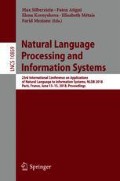Abstract
A Question Classification is an important task in Question Answering Systems and Information Retrieval among other NLP systems. Given a question, the aim of Question Classification is to find the correct type of answer for it. The focus of this paper is on Arabic question classification. We present a novel approach that combines a Support Vector Machine (SVM) and a Convolutional Neural Network (CNN). This method works in two stages: in the first stage, we identify the coarse/main question class using an SVM model; in the second stage, for each coarse question class returned by the SVM model, a CNN model is used to predict the subclass (finer class) of the main class. The performed tests have shown that our approach to Arabic Questions Classification yields very promising results.
Access this chapter
Tax calculation will be finalised at checkout
Purchases are for personal use only
Notes
- 1.
A closer scrutiny of the patterns that were used in [2] has shown that they do not cover all the possible variations of uses of Interrogative Patterns in different contexts and settings.
- 2.
- 3.
- 4.
The dataset is available at http://cogcomp.org/Data/QA/QC/.
- 5.
- 6.
References
Abdelnasser, H., Ragab, M., Mohamed, R., Mohamed, A., Farouk, B., El-Makky, N., Torki, M.: Al-Bayan: an Arabic question answering system for the Holy Quran. In: Proceedings of the EMNLP 2014 Workshop on Arabic Natural Language Processing (ANLP), pp. 57–64 (2014)
Al Chalabi, H.M., Ray, S.K., Shaalan, K.: Question classification for Arabic question answering systems. In: International Conference on Information and Communication Technology Research (ICTRC), Abu Dhabi, United Arab Emirates, pp. 310–313. IEEE (2015)
Aouichat, A., Guessoum, A.: Building TALAA-AFAQ, a corpus of Arabic FActoid question-answers for a question answering system. In: Frasincar, F., Ittoo, A., Nguyen, L.M., Métais, E. (eds.) NLDB 2017. LNCS, vol. 10260, pp. 380–386. Springer, Cham (2017). https://doi.org/10.1007/978-3-319-59569-6_46
Breiman, L.: Random forests. Mach. Learn. 45(1), 5–32 (2001)
Chollet, F., et al.: Keras: https://github.com/fchollet/keras (2015)
Dahou, A., Xiong, S., Zhou, J., Haddoud, M.H., Duan, P.: Word embeddings and convolutional neural network for arabic sentiment classification. In: The 26th International Conference on Computational Linguistics: Proceedings of COLING 2016, Technical Papers, pp. 2418–2427 (2016)
Eisele, A., Chen, Y.: MultiUN: a multilingual corpus from united nation documents. In: Tapias, D., Rosner, M., Piperidis, S., Odjik, J., Mariani, J., Maegaard, B., Choukri, K., Chair, N.C.C. (eds.) Proceedings of the Seventh Conference on International Language Resources and Evaluation, pp. 2868–2872. European Language Resources Association (ELRA), May 2010
Hasan, A.M., Zakaria, L.Q.: Question classification using support vector machine and pattern matching. J. Theor. Appl. Inf. Technol. 87(2), 259–265 (2016)
Hearst, M.A., Dumais, S.T., Osuna, E., Platt, J., Scholkopf, B.: Support vector machines. IEEE Intell. Syst. Appl. 13(4), 18–28 (1998)
Huang, Z., Thint, M., Qin, Z.: Question classification using head words and their hypernyms. In: Proceedings of the Conference on Empirical Methods in Natural Language Processing, 25–27 October (Sat-Mon) in Waikiki, Honolulu, Hawaii, pp. 927–936. Association for Computational Linguistics (2008)
Kim, Y.: Convolutional neural networks for sentence classification. arXiv preprint arXiv:1408.5882 (2014)
Kingma, D., Ba, J.: Adam: A method for stochastic optimization. arXiv preprint arXiv:1412.6980 (2014)
Li, X., Roth, D.: Learning question classifiers. In: Proceedings of the 19th International Conference on Computational Linguistics-Volume 1, Taipei, Taiwan, 24 August–01 September, pp. 1–7. Association for Computational Linguistics (2002)
Mikolov, T., Sutskever, I., Chen, K., Corrado, G., Dean, J.: Distributed representations of words and phrases and their compositionality. In: Proceedings of the 26th International Conference on Neural Information Processing Systems - Volume 2, NIPS 2013, pp. 3111–3119. Curran Associates Inc., USA (2013). http://dl.acm.org/citation.cfm?id=2999792.2999959
Nair, V., Hinton, G.E.: Rectified linear units improve restricted boltzmann machines. In: Proceedings of the 27th International Conference on Machine Learning (ICML-2010), pp. 807–814 (2010)
Nyberg, E., Mitamura, T., Carbonnell, J., Callan, J., Collins-Thompson, K., Czuba, K., Duggan, M., Hiyakumoto, L., Hu, N., Huang, Y.: The JAVELIN question-answering system at TREC 2002. NIST SPEC. PUBL. SP 251, 128–137 (2003)
Ray, S.K., Singh, S., Joshi, B.P.: A semantic approach for question classification using WordNet and Wikipedia. Pattern Recognit. Lett. 31(13), 1935–1943 (2010)
Salton, G., Wong, A., Yang, C.S.: A vector space model for automatic indexing. Commun. ACM 18(11), 613–620 (1975). https://doi.org/10.1145/361219.361220
Scherer, D., Müller, A., Behnke, S.: Evaluation of pooling operations in convolutional architectures for object recognition. In: Diamantaras, K., Duch, W., Iliadis, L.S. (eds.) ICANN 2010. LNCS, vol. 6354, pp. 92–101. Springer, Heidelberg (2010). https://doi.org/10.1007/978-3-642-15825-4_10
Silva, J., Coheur, L., Mendes, A.C., Wichert, A.: From symbolic to sub-symbolic information in question classification. Artif. Intell. Rev. 35(2), 137–154 (2011)
Skilling, J.: Maximum Entropy and Bayesian Methods. Springer Science & Business Media, Netherlands (1988)
Vapnik, V.: The Nature of Statistical Learning Theory. Springer science & business media, New York (2013)
Author information
Authors and Affiliations
Corresponding author
Editor information
Editors and Affiliations
Rights and permissions
Copyright information
© 2018 Springer International Publishing AG, part of Springer Nature
About this paper
Cite this paper
Aouichat, A., Hadj Ameur, M.S., Geussoum, A. (2018). Arabic Question Classification Using Support Vector Machines and Convolutional Neural Networks. In: Silberztein, M., Atigui, F., Kornyshova, E., Métais, E., Meziane, F. (eds) Natural Language Processing and Information Systems. NLDB 2018. Lecture Notes in Computer Science(), vol 10859. Springer, Cham. https://doi.org/10.1007/978-3-319-91947-8_12
Download citation
DOI: https://doi.org/10.1007/978-3-319-91947-8_12
Published:
Publisher Name: Springer, Cham
Print ISBN: 978-3-319-91946-1
Online ISBN: 978-3-319-91947-8
eBook Packages: Computer ScienceComputer Science (R0)

